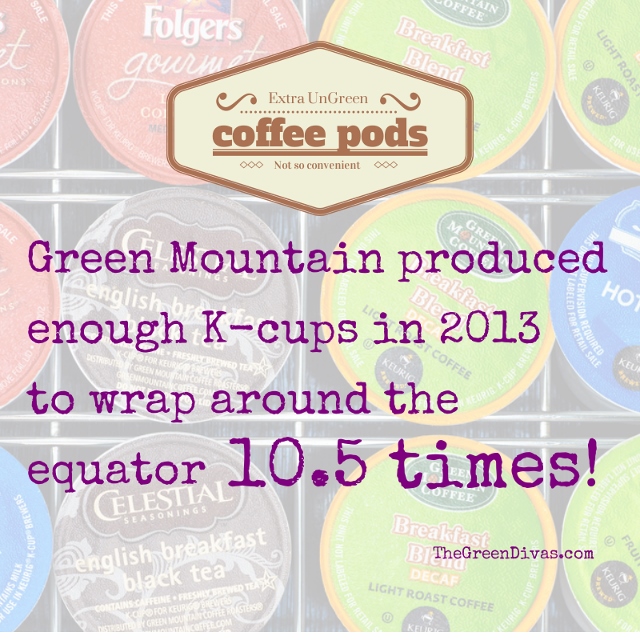These all-in-one coffee and filter thangs—coffee pods, or “K-Cups” as most people know them—are a quick way to make just one cup.
But K-Cups are also a quick way to wreak havoc on the environment and, quite possibly, our health. Not so convenient!
My son, who just turned 13, had been begging for one of these machines for Christmas. Yes, he drinks coffee.
My husband, a busy man who likes both coffee and convenience, was into the idea. But not me. Whenever the subject came up, which it did quite often, I went on one of my Green Diva rants. The packaging waste! Our society’s “need” for instant gratification! The plastic! The horror! I even offered to brew coffee for them every weekend, despite the fact I’m a green tea drinker. (Side note: During my advertising exec days, I downed a Venti iced skim latte hold the ice on a daily basis.)
Guess what my son got for Christmas? You guessed it. A Keurig single-cup coffee brewer from the dark side.
And I had nothing to do with it. I think my son was even more surprised by this gift than I!
Thinking he’d escape the wrath of Lynn, my husband searched and searched online for the coffee pods with the least environmental impact (during which time he could have brewed a year’s worth of coffee the old-fashioned way). I have to give him some credit for the effort—he tracked down an organic coffee that makes compostable coffee pods. However, only the filter and coffee grounds are compostable. The plastic part on top of the pod gets tossed into the regular garbage. Do you think my son and husband are separating these pods? Nope. That would take time. And I’m pretty sure they don’t even realize that’s what they need to do in order for the pods to be somewhat eco-friendly (can you tell this really steams me?).
Of course, if they did take the time to dispose of the coffee pods properly, that would cancel out the convenience factor.
It’s too late for me and my family, but I dug up some un-green facts about coffee pods and K-Cups for the rest of you. I hope you’ll share this to help sway others to brew coffee the old-fashioned way and give the earth a break.
Here are 5 inconvenient facts about K-Cups (and coffee pods) & the environment:
1. In 2013, Green Mountain produced 8.3 billion K-Cups, enough to wrap around the equator 10.5 times (Source: Mother Jones).
This year, Green Mountain signed a10-year agreement with Coca-Cola (with Coca-Cola owning 10 percent of Green Mountain) to create some type of single cup cold beverage whatever. No doubt, those K-Cup numbers will increase exponentially as a result—maybe they’ll pile up high enough to reach the moon. It’s worth noting that Coca-Cola was a nominee for Corporate Accountability International’s 2013 Hall of Shame for obstructing national park efforts to go bottled-water- free. Nice work, Coke.
2. Only five percent of its current cups are made out of recyclable plastic.
The rest is number seven plastic, non-recyclable in most places. On a side note: What about the leaching from the plastic? There’s hot water going through all those plastic brewing system (true for many traditional coffee-makers). BPA-Free is turning out to be just as bad (sometimes worse) than BPA.
3. Once the machines break down, it’s mostly plastic.
Hello landfills. Plastic never biodegrades—it photodegrades. That means it ends up breaking down into tiny particles of plastic that end up in our waterways and, eventually, the food chain. Might as well sprinkle this on your coffee!
4. If you’re a Green Dude or Diva and your significant other is not, the coffee pods my create tension in your relationship.
Every time I see that machine, I cringe. The la-dee-da organic, somewhat recyclable coffee pods my husband purchased do not make up for the fact that these coffee pods are the epitome of the un-green. There’s a bit of resentment that stirs in my gut every time I hear that contraption warming up.
5. Using K-cups could cause weight gain over time.
Think of the calories you could be expending to open a bag of coffee beans and grind them up (to save time, use one of those new-fangled coffee grinders). Put the ground beans and some boiling water into a coffee press (these are made of glass—guaranteed not to leach plastic toxins, which may lead to obesity). Soon, you have some tasty coffee. During that short wait time, you can take a bathroom break or tie your shoes. If you want to save a little time, tie your shoes while taking the bathroom break (men, tying your shoes is not recommended while standing).
If you already have a Keurig at home, here are 5 ways to reduce the impact on the environment:
1. Purchase a reusable filter.
Buy the gold cup version, otherwise it will have plastic parts which may leach toxins into your coffee making it more of a witch’s brew.
2. Don’t buy any more K-cups until 2020.
Keurig Green Mountain has a sustainability target to make all K-cups 100 percent recyclable by then.
3. Purchase one of their K-Cup collection bins, available in 48 states.
They’re not cheap. The grounds are turned into compost and the rest is incinerated and converted into energy. But does this really cancel out the production of the pods and the fact you have to pay for the special collection bins and ship them? I’m not a rocket scientist (if you are, I’d love an analysis), but seems like a lot of work in the name of “convenience.”
4. Find a sustainable-ish coffee pod brand.
We use San Francisco Bay Organic.
5. In the middle of the night, stage a fake break-in.
Disappear the Keurig and a few other valuables which you can secretly donate.
Check out my Green Divas podcast:
***
Adapted from “5 Ways Coffee Pods Harm the Planet.”
Love elephant and want to go steady?
Sign up for our (curated) daily and weekly newsletters!
Editor: Jenna Penielle Lyons
Photo: Courtesy of the author












Read 5 comments and reply